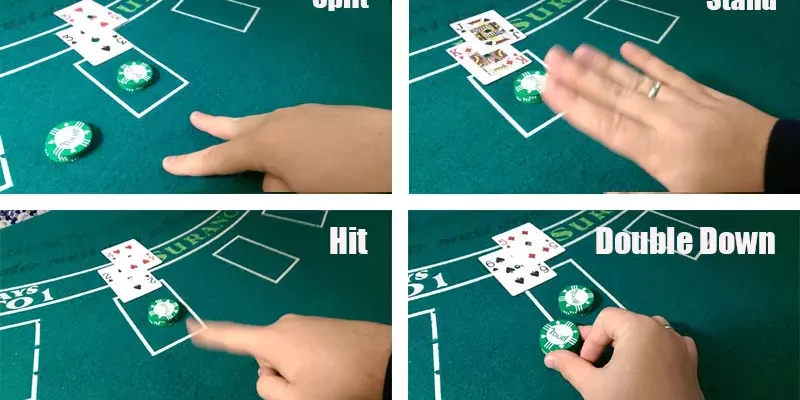In the realm of casino gaming, few games carry the same allure and mystique as blackjack. As players sit around the green felt table, engaged in a battle of wits against the dealer, communication becomes key. While verbal cues are certainly important, seasoned players understand that mastering the art of hand signals is essential for smooth gameplay and maintaining the integrity of the game. Join us as we delve into the intricacies of blackjack hand signals, exploring their history, significance, and practical application in the world of casino gaming.
1. The Origins of Blackjack Hand Signals
The roots of blackjack hand signals can be traced back to the game’s early days, when it was known as “21” and played in the smoky backrooms of Old West saloons. In those days, verbal communication was often drowned out by the clamor of the gaming tables, leading players and dealers alike to develop a system of non-verbal cues to facilitate gameplay. Over time, these hand signals became standardized, evolving into the universal language of blackjack that we know today.
2. The Importance of Hand Signals in Blackjack
In a game where split-second decisions can make all the difference, clear and concise communication is paramount. Hand signals serve as a visual cue that allows players to convey their intentions to the dealer and fellow players without the need for verbal explanation. This not only streamlines the gameplay process but also helps to prevent misunderstandings and disputes, ensuring a fair and enjoyable gaming experience for all involved.
3. Understanding the Basics: Common Hand Signals in Blackjack
While the specific hand signals used may vary slightly from one casino to another, there are several standard gestures that are universally recognized in the world of blackjack. These include:
- Hit: To request another card from the dealer, simply tap the felt next to your cards with a single finger. This subtle gesture indicates your desire to receive an additional card without disrupting the flow of the game.
- Stand: When you’re satisfied with your hand and wish to receive no further cards, simply slide your cards under your chips or wave your hand horizontally over them. This signals to the dealer that you’re opting to stand pat and are content with your current total.
- Double Down: If you wish to double your initial bet and receive only one additional card, place an equal amount of chips next to your original wager and extend your index finger upward. This signals to the dealer that you’re doubling down on your hand and signifies your intention to receive one more card only.
- Split: When you’re dealt a pair of cards of equal value, you have the option to split them into two separate hands. To do so, place an additional bet equal to your original wager next to your cards and extend your index and middle fingers in a V-shape. This signals to the dealer that you’re splitting your pair and wish to play each card as a separate hand.
- Insurance: In the event that the dealer’s upcard is an Ace, players have the option to take insurance against the dealer having a natural blackjack. To signal your decision to take insurance, place an additional bet equal to half of your original wager in the designated insurance area and extend your index finger horizontally across the felt.
4. Advanced Hand Signals and Etiquette
While the basic hand signals outlined above are sufficient for most situations, seasoned players may employ more advanced gestures to convey specific actions or strategies. For example, some players may use subtle hand signals to communicate with their fellow players or to indicate their intention to surrender their hand. Additionally, proper etiquette dictates that players should refrain from touching their chips or cards once their bets have been placed, as this could be interpreted as an attempt to cheat or manipulate the outcome of the game.
5. The Evolution of Hand Signals in the Digital Age
In recent years, the rise of online and mobile blackjack has led to a decline in the use of traditional hand signals in some gaming environments. However, many players still prefer the tactile experience of playing at a physical table, where the art of hand signaling remains an integral part of the gameplay. Even in virtual settings, some online casinos have incorporated digital hand signals into their user interfaces, allowing players to communicate their actions visually to the dealer and other players in real-time.
6. Conclusion: Mastering the Language of Blackjack Hand Signals
In the fast-paced world of blackjack, clear and effective communication is essential for success. By mastering the art of hand signals, players can navigate the complexities of the game with confidence and precision, enhancing their overall gaming experience and maximizing their chances of winning. Whether you’re a seasoned pro or a novice player, understanding and utilizing blackjack hand signals is sure to elevate your gameplay to new heights. So the next time you take a seat at the blackjack table, remember to let your hands do the talking.
Blackjack Hand Signals FAQ
1. Why are hand signals used in blackjack?
Hand signals serve as a universal language at the blackjack table, allowing players to communicate their intentions to the dealer and fellow players without the need for verbal explanation. This helps to streamline gameplay, prevent misunderstandings, and maintain the integrity of the game.
2. Are hand signals required in all casinos?
While hand signals are commonly used in most casinos, their usage may vary slightly from one establishment to another. It’s important to familiarize yourself with the specific hand signals required at the casino where you’re playing to ensure smooth and efficient communication with the dealer.
3. Can I use verbal cues instead of hand signals?
While verbal cues are allowed in some casinos, it’s generally preferred that players use hand signals to communicate their actions at the blackjack table. This helps to minimize confusion and ensures that all players are on the same page during gameplay.
4. What are the basic hand signals in blackjack?
The basic hand signals in blackjack include:
- Hit: Tap the felt next to your cards with a single finger to request another card from the dealer.
- Stand: Slide your cards under your chips or wave your hand horizontally over them to indicate that you’re satisfied with your hand and wish to receive no further cards.
- Double Down: Place an additional bet equal to your original wager next to your cards and extend your index finger upward to signal that you’re doubling down on your hand.
- Split: Place an additional bet equal to your original wager next to your cards and extend your index and middle fingers in a V-shape to indicate that you’re splitting your pair into two separate hands.
- Insurance: Place an additional bet equal to half of your original wager in the designated insurance area and extend your index finger horizontally across the felt to signal that you’re taking insurance against the dealer having a natural blackjack.
5. Can I use hand signals to communicate with other players?
While hand signals are primarily intended for communication with the dealer, some players may use subtle gestures to communicate with their fellow players. However, it’s important to exercise caution and avoid disrupting the flow of the game or giving away sensitive information to other players.
6. Are there any advanced hand signals in blackjack?
While the basic hand signals outlined above are sufficient for most situations, some players may use advanced gestures to convey specific actions or strategies. These gestures may vary depending on individual preferences and playing styles, but they should be used judiciously to avoid confusion or misinterpretation.
7. How can I learn more about hand signals in blackjack?
The best way to learn about hand signals in blackjack is to observe experienced players in action and familiarize yourself with the specific signals used at the casino where you’re playing. You can also consult the casino’s rules and regulations or ask the dealer for clarification if you have any questions during gameplay.
Also Read: https://casinobolds.co.uk/















Comments